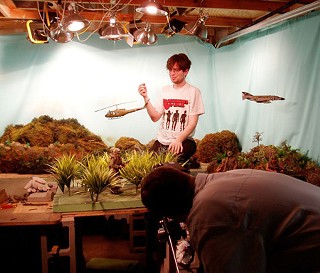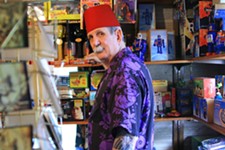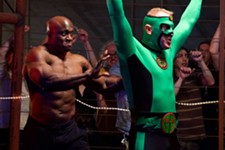Plastic Platoon
Paul Hanley and Kieran Healy on their 10-year tour of duty to make a stop-motion Vietnam epic starring action figures
By Marc Savlov, Fri., Jan. 22, 2010
"It's silly talking about how many years we will have to spend in the jungles of Vietnam when we could pave the whole country and put parking stripes on it and still be home for Christmas."
– Ronald Reagan interview, Fresno Bee, Oct. 10, 1965
So we lost that one for the Gipper, sure, but in artistic – and specifically cinematic – terms, the Vietnam War was a huge win for our side. Nearly four decades since the fall of Saigon, more critically successful and culturally influential films have been made about Vietnam than any other war in history. And not only that: We even ended up getting our all-American pavement 'n' parking stripes emblazoned atop what were once the claymored dirt alleyways of Saigon, which are now the bustling, capitalist-thronged (and thoroughly well-paved) streets of Ho Chi Minh City.
Still, Vietnam remains something of a taboo subject to – no pun intended – mine for humor when it comes to filmic re-enactments. War is hell, and hell is rough terrain for comedy if you're not Dante Alighieri or Joseph Heller. Robert Altman's stridently anti-war ensemble epic M*A*S*H (and the ensuing television series) was set during the Korean War, Barry Levinson's Good Morning, Vietnam is as much a showcase for Robin Williams as it is a Vietnam pic, and while Spalding Gray's Jonathan Demme-directed Swimming to Cambodia is often hilarious, it's also, ultimately, a monologist's footnote to film about the actual events.
Vietnam ≠ big yuks. Until now, that is.
Enter Paul Hanley and Kieran R. Healy's epic tale of small-scale blood, guts, and action figures, Viva the Nam, the first DIY, feature-length, stop-motion Vietnam comedy ever made. Director Hanley and director of photography/editor/sound designer Healy have made a 12-frames-per-second, 104-minute statement on America's Southeast Asian imbroglio: awash in period detail; jittery, you-are-there camerawork; and enough misguided period pathos to earn a place in the Halls of Montezuma or a beachhead on the shores of Tripoli.
And because it took the two of them – with assistance from Lee Sparks in the miniatures department and a handful of friends, including sometime Chronicle contributor Spencer Parsons, handling voice talent – a full 10 years to complete, Viva the Nam is likely the last independently financed stop-motion comic commentary on the 'Nam you'll see anytime soon. War is hell, but re-creating it at 1/6th scale, and then making it funny, is a journey into the heart of – pun intended – dorkness that even the well-financed folks at the Cartoon Network's Robot Chicken would be hard-pressed to pull off on what Hanley unceremoniously describes as a budget "that cost about as much as a good used car."
Viva the Nam begins with a phone call and a flashback to a simpler time. Retired Marine and embittered Vietnam vet Joe Holmes calls his son, Pvt. Joe Holmes Jr., currently serving in Baghdad, to warn him of his fate: Every single branch of the Holmes family tree has lost a man to war. Watch your ass, kid, he cautions, and hang on to that lucky medallion I gave you.
Flash back to 1969 and a younger, more idealistic Joe Sr., who bears a striking if unlicensed resemblance to a certain Lucasfilm scoundrel and hotshot space cowboy whose name, for copyright reasons, shall go unmentioned here. Joe Holmes is tuning in, turning on, and dropping out at Andy Warhol's Factory, mingling, Forrest Gump-like, with cameoing characters that run the gamut from obscurely filmic (Beyond the Valley of the Dolls' Z-Man makes a brief appearance, as does Lon Chaney Sr., in his unmistakable London After Midnight garb) to more flesh-and-blood (but plastic) icons like Hunter S. Thompson, who gets into a drug-addled dustup with Charles Manson, and Lou Reed ("What're you doing here?" Holmes asks the velveteen undergrounder. "I'm waiting for the Man, man," is Reed's droll reply).
It's at the Factory that Holmes receives a telegram – ostensibly from the Helping Hand Acceptance Corporation, one of Hanley's many cinematic in-jokes, this one referencing Repo Man, that soon enough finds him drafted into the U.S. Marine Corps, barely surviving a basic training overseen by a small, plastic R. Lee Ermey.
Once in-country, Holmes is attached to the "Bastard Squad," a genre-enthusiast's wet dream of racial and cinematic stereotyping, and begins his 1/6th-scale descent into a jarringly realistic world of the quick, the dead, and the very small. Explosions and appropriately inappropriate comic hijinks ensue, chief among them an inspired sequence of bloodthirsty, "Get some!" GI slaughter set to equally maniacal sounds of the Trashmen's classic "Surfin' Bird"; a drunken, rousing rendition of Sam the Sham & the Pharaohs' "Wooly Bully," complete with absurdist subtitles; and a spot-on, black-and-white re-creation of old-school military training films starring – who else? – Big Duke Wayne. Real, reel, or patently surreal, if it was in the 'Nam, chances are you'll see some twisted variation of it in Viva the Nam.
"We started this film thinking it would be a kind of calling card for our talents," says Hanley, "and now, 10 years later, it's like its own end product. It was a case of 'Here, check out what we did, and then hire us,' which is ironic because, you know, now I don't think I'll ever work in the film industry again. After 10 years of working on Viva the Nam, it's just not what I'm interested in doing anymore. I'm into writing comics now because it's a natural outlet for the kinds of stories I write, which are in some ways just like Viva the Nam: They're big, epic things."
Adds Healy, from his new digs in New York City where he works as an editor on the reality television show LA Ink: "We didn't use toys to be coy or send some kind of message or anything like that. We used toys because that was the best way to tell the story, cheaply. Our buddy Lee Sparks, who was the number three guy on the movie, wanted us to insert jokes self-referencing the fact that these actors were actually toys, but that wasn't really what we were after. The best compliments I've had on the movie so far have come from people who say, 'I forgot I was watching toys after 10 minutes!'"
Hanley looks a good 10 years younger than his current 33 and speaks about war, movies, and related supercoolness with the breathless (and voluminous) surety of a natural-born film geek, riffing on everything from the greatness of Donald Sutherland's role of Oddball in 1970's Three Kings template Kelly's Heroes to the virtual impossibility of securing music clearances for the various and sundry period temp-tracks on Viva the Nam's soundtrack. (The Doors are, after all, tough to get by phone these days.)
He also readily cops to the fact that because so many of the action figures in the film are recognizable from their real-world, real-life counterparts, and due to the fact that he and Healy were generally too busy working on the intricacies of filming the project to actually secure the rights to any of the action figures used in the production, that too could lead to some difficulties securing any kind of distribution or DVD release. "What I really need, badly," he says, "is an agent."
Admittedly, working with 1/6th-scale dolls has had an influence on him: "Because of Viva the Nam, I've gotten into the hobby of these 1/6th-scale military figures, and you'd be amazed at what's available out there. I've got a 1/6th-scale Telly Savalas as Big Joe from Kelly's Heroes.
"There's a huge market for both movie-related action figures and just regular World War II figures in Japan for some reason. I'm pretty sure they're not licensed, so they sell them under names like 'Reilly's Heroes' to avoid copyright infringement," Hanley continues. "It's a really bizarre toy market they've got over there, but that's how we were able to get so many celebrity faces in the movie – they're not licensed figures; they're just knockoff likenesses from the gray market in Japan. Figures like, say, the character of Sgt. Salt in our movie was actually a James Coburn in Cross of Iron knockoff figure, if you can believe it.
"Before we did Viva the Nam, Kieran and I did a stop-motion short called War American Style [which can be viewed in full on YouTube], where we really went nuts with the action-figure cameos. Steve McQueen and his catcher's mitt from The Great Escape is in there, Charles Bronson, Telly Savalas, Lee Marvin. We had all the POWs from all the POW movies in one POW camp together at one point."
Viva the Nam's atypical gestation, which began in 2000 with Hanley and Healy, college buddies from the University of Texas' Department of Radio-Television-Film, deciding to combine their respective skills, can be broken down into four distinct parts:
2000-2002: Getting their bearings, doing research, and generating ideas. Explains Healy: "Essentially Paul would write a treatment, and then we built a set and started shooting on it. After a bit we realized that the treatment Paul wrote would take hours and hours to watch, so we scaled it down. That's right: The final cut of Viva the Nam is a scaled-down version of what we had actually planned to do."
2003-2006: Healy continues: "Paul and I hammered out a story from beginning to end and began shooting it for real five to six nights a week, sometimes overnight, on top of a normal day job. We shot on a Canon Scoopic 16M, which is an old camera that was primarily used for shooting newsreel B-camera [and was first introduced to the public in April 1973]. We chose that particular camera because it had a single-frame feature for doing stop-motion and because it had a nice zoom lens with a macro on it which allowed us to get in real close and distort the perspective to make everything look bigger than it actually was.
2006-2007: "Paul sat down and wrote the physical script so that we'll have the lines that people will speak, and we began to gather friends and relatives to help us with the voice work."
2007-Present: "Editing and sound design. I discovered why there is a reason for multiple people editing, sound design, and sound editing: It's hard and it takes a long time to get right. On top of that, during this time I moved to NYC to start working in television, so Paul and I began to collaborate over the Internet. I would upload segments of the movie, and he would give me notes on what worked and what didn't."
Ultimately, the film was finished (albeit with a rough sound mix) in time for inclusion in the third GI Joe Stop-Motion Film Festival, a popular touring festival that the duo had worked with in the past. Unfortunately, this time the relationship soured (the filmmakers are mum on the exact reasons), and Viva the Nam was left to fend for itself. Not that Hanley and Healy are complaining.
"We're basically touring the film around in the hopes that somebody will see the film and decide to help us out," says Healy, "both in terms of distribution and securing music rights. Neither Paul nor I are musicians, so we can't do the music, and because the film is completely self-financed, we're out of funds. It's not just that we can't afford the rights to the Doors, but we also can't afford to pay people to play music that sounds like the Doors. So we're kind of looking for that person who will see the film and say: 'You know what, guys? Here's what I can do for you.'"
Consider the epic proportions of the whole undertaking, which involved two hours and 45 minutes of raw, unedited, stop-motion footage and incorporated, according to Hanley, "somewhere between 75,000 and 150,000 individual character or camera movements." (The exact number of single-frame movements in the film is unknown, because many of the sequences were "two-framed.") That's not to mention the time spent, as Hanley says, "rebuilding sets from shot to shot as we changed angles."
Suffice to say, the illusion is exacting, the level of detail impressive (Hanley grabbed some Korean newspapers from a grocery in North Austin and then hand-drew "Vietnamese" signage to place in the background of key shots), and the artifice, while totally artificial, remains engrossingly realistic.
"When we started making the film," says Healy, "stop-motion was very much a dying art form and was in the process of being almost completely replaced by CGI. But I think people are missing that tactile feel that stop-motion provides. CGI is weightless – it's all about being able to do virtually anything with the camera that you want to. With stop-motion, it's all about the limits that are imposed upon you by the format, and those limits kind of force you to be a little more creative. Not that CGI is uncreative, but stop-motion is real. Whatever you see up on the screen physically happened in the real world. And I think a lot of people miss that."
Viva the Nam's world premiere takes place Wednesday, Jan. 27, 7pm, at the Alamo Drafthouse at the Ritz. For more info, visit www.originalalamo.com.










